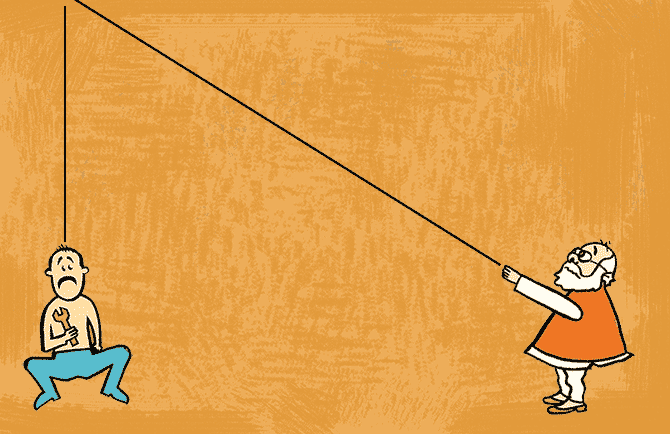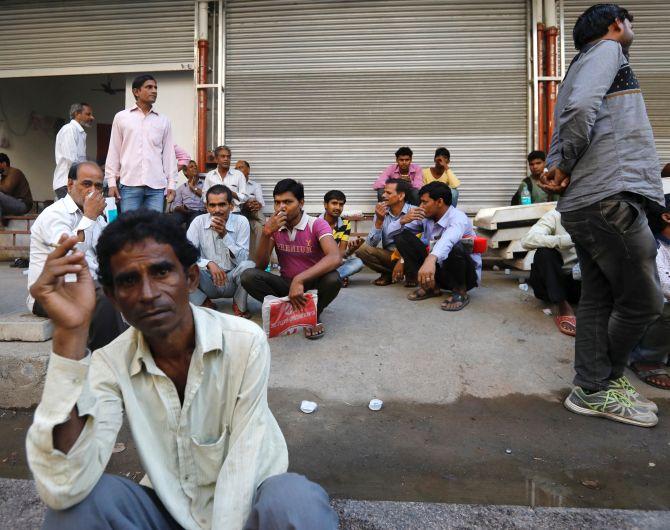'When you do some job for a few hours, you are hardly earning enough to survive.'

There was euphoria in social media about India becoming a $4 trillion economy a few days ago. The fact is, India has not yet reached the threshold.
The question is, is the GDP of a country with 1.4 billion people becoming a $4 or 5 trillion economy something to be jubilant about?
Then came the data from CMIE that unemployment rate rose to a 2 year high of 10.09% in October 2023.
But according to government data and the economists at the State Bank of India, India's unemployment rate is at a record low.
"What we are witnessing is jobless growth," R Nagaraj, former professor of economics at the Indira Gandhi Institute of Development Research, tells Rediff.com's Shobha Warrier.
The CMIE data says the unemployment rate rose to a 2 year high of 10.09% in October 2023, almost 3% increase from September. But the government figure for unemployment in 2022-2023 is just 3.1%. Where lies the truth?
I would go with the annual PLFS (Periodic Labour Force Survey) data released by the National Sample Survey Office (NSSO), that is, the government data.
The PLFS survey result is very positive and pleasing to the government.
The three things the survey highlighted are, the unemployment rate has declined from over 6% five years ago to 3.1% today.
Second, the labour force participation rate, that is the percentage of population working or willing to work or available for work, has increased.
Third, participation of women in the labour market has increased.
This data is for year 2022-2023.
It is based on this that the SBI report says, the labour market is doing very well.

Is this the truth?
That's what I want to explain. These are the headline results announced by the government, that the labour market is performing well and very favourable to them.
But when you look at closely, there are concerns.
Yes, after the pandemic, the economy has been recovering and obviously, employment also recovered.
So, the improvement in the labour market is part of that economic recovery process.
The question is, what kind of employment is being generated.
This is a country with surplus labour and open employment is generally very low, as it is very difficult to remain unemployed as you have to do some job to survive. So, people do any job to survive.
What is predominant in India is disguised unemployment.
When you do some job for a few hours, you are hardly earning enough to survive.
Having such a job doesn't mean you have a regular job with a regular salary which can take care of the needs of you and your family.
The SBI report says, there is a 'structural transformation in the labour market' and people are moving to self-entrepreneurship.
Is it not a fact that when there is no job in the market, people have to do something to survive? Are they camouflaging unemployment by using the term structural transformation?
Yes, they are. There are three categories of jobs.
One is the regular wage salaried worker. Two, casual labour getting paid for what he does.
Third is self-employment which includes a person opening a tea stall in front of his house as he has no other job. This is, in fact, disguised employment.
When you say unemployment has declined, the truth is, self-employment has gone up.
While self-employment has gone up, regular employment or casual employment has come down.
The fact is, there are not enough jobs in the market.

Does that mean we are in a situation where the government is satisfied with the data while people are unhappy as there are not enough jobs?
Absolutely. These numbers are just pleasing to the policymakers.
In fact, the report has taken care of some of the concerns of those who have been saying that unemployment is rising, labour participation is declining especially that of women, etc.
But the reality is quite different from what these reports say.
When India is said to be going at more than 6%, why are jobs not being created accordingly? Are we once again talking about jobless growth?
Yes. What we are witnessing is jobless growth. Even when jobs are created, what are the wages?
When jobs are created and wages are rising, it is productive employment. In an economy where there is productive employment, you contribute to the society.
When the wages and earnings are low, you are just surviving on what is available.
Self-employment of this kind hardly adds to the income of the country. There is only redistribution of what is already there.
When the opposition has been making noise about unemployment, this data is released to contest that narrative.

IMAGE: Professor R Nagaraj.
What are the reasons for this jobless growth?
Yes, the economy is growing, but the kind of growth we are creating is not labour intensive. It is not creating adequate labour demand.
Agriculture is growing at a modest pace. Manufacturing is in doldrums. So, the sectors that can create jobs are not creating jobs.
What you are creating is refuge employment in services sector. And it is not in the high-end services sector that jobs are growing.
It is in the self-employed sector that jobs are growing where people are selling potatoes and pakodas.
This is hardly adding any value to the economy.
For example, when there are ten vada paav sellers in one street, addition of one more seller it does not add much value.
Another shocking thing is, about 23% of the jobs created are supplementary jobs in the household sector when the entire family works say, in their kirana store. This is actually unpaid labour.
Another data says, the growth of unpaid workers rose from 40 million in 2017-2018 to 95 million in 2023...
This is exactly what I am saying. When the government says, employment has been created, it is basically unpaid family labour, where the current earnings get distributed within the family or household.
When a person cannot find a job outside, he joins the family unit as he has no other job.
This does not bring in additional income for the family. So, this is not productive employment.
Is it because the manufacturing sector, which can be the largest employer, has not been growing that jobs are not being created?
It is one of the reasons. The manufacturing sector has not been growing at the desired pace. In fact, employment in the manufacturing sector has been declining.
Our non-agricultural sector growth has been very lopsided.
You have output growth only in the high-paid IT sector which employs a maximum of about 5 million people.
What is 5 million when the size of the workforce is about 470 million? So, the high paid IT services is only a drop in the ocean.
Because they get high salaries, the income of the country gets elevated. But you have to understand that the income is only in the small pockets such as Bangalore or Hyderabad or Gurgaon.
The fact is, majority of the people have very poor jobs which are hardly productive.

Do you feel investment in the manufacturing sector has not been happening as investors have no faith the market?
Yes. The investment rate in the economy, which is the gross capital formation of the GDP, has declined in the last decade.
From 2012-2022, it has declined from 34% to 28% approximately. And manufacturing sector's share in gross capital formation has hardly grown.
The 2023 State of Working India report by Azim Premji University found that 42.8% of graduates under 25 are unemployed.... Should this not worry the government?
Yes. This report has very good statistics.
Youth unemployment is very high in India.
Youngsters get educated and when they come out of the colleges, there are no jobs waiting for them.
There is a lot of noise about India becoming a $5 trillion economy. When you have a population of 1.4 million, is it not natural to have a large economy? Shouldn't we be using per capita income as the growth indicator and not the size of the economy?
Exactly. The present government has mastered the art of talking in absolute numbers.
Absolute size doesn't matter as we are a nation of 1.4 billion people.
Per capita income should the right measure, and it has not increased much in the last decade, compared to say, the first decade of the 21st century.
As per the 2020 report, we are ranked at 142 out of 197 countries....
Let's admit, in absolute size, India is a large economy because of the population.
In per capita income, we continue to be a poor economy. Our rank has not improved steadily in the last 10 years.
Our growth rate has decelerated in the last decade after the dream run from 2003-04 to 2009-10.
The reason for the decline is because our investment rate has declined. That's why we are not growing fast enough.
Feature Presentation: Rajesh Alva/Rediff.com









